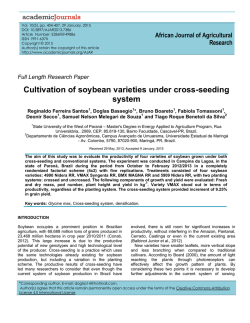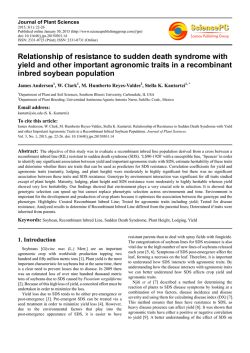
Impact of nutrient management technologies in transplanted rice
Vol. 10(5), pp. 345-350, 29 January, 2015 DOI: 10.5897/AJAR2014.8688 Article Number: 60411C949854 ISSN 1991-637X Copyright © 2015 Author(s) retain the copyright of this article http://www.academicjournals.org/AJAR African Journal of Agricultural Research Full Length Research Paper Impact of nutrient management technologies in transplanted rice under irrigated domains of Central India A. K. Singh1*, U. S. Gautam2, J.Singh3, A. Singh4 and P. Shrivastava5 1 Department of Soil Science, Jawaharlal Nehru Krishi Vishwa Vidyalaya, Krishi Vigyan Kendra, Katni-483 442, Madhya Pradesh, India. 2 Zonal Project Directorate, Zone-VII, ICAR, JNKVV Campus, Adhartal, Jabalpur-482004 (MP), India. 3 Department of Plant Protection, Jawaharlal Nehru Krishi Vishwa Vidyalaya, KrishiVigyan Kendra, Sidhi-486661 (MP), India. 4 Department of Home Science, Jawaharlal Nehru Krishi Vishwa Vidyalaya, KrishiVigyan Kendra, Chhattarpur-471201 (MP), India. 5 Department of Agricultural Engineering, Jawaharlal Nehru Krishi Vishwa Vidyalaya, KrishiVigyan Kendra, Narsinghpur-487001 (MP), India. Received 14 March, 2014; Accepted 9 January, 2015 An experiment on impact of different approaches of nutrient management in transplanted rice was conducted in participatory mode on mixed red to shallow black soils under irrigated domains in Kymore Plateau and Satpura Hills zone of central India. The study was carried out for three consecutive years since kharif 2008. The results revealed that the application of organic inoculants viz. blue green algae (BGA) and phosphate solubilizing bacteria (PSB) with NPK nutrients on soil test crop response (STCR) basis recorded higher grain yield (4.025 tonne ha-1) and straw yield (6.68 tonne ha-1) of rice. Further higher gross returns, net returns, yield response (kg) kg-1 nutrients use and net return (Rs) Re-1 spent on nutrients were observed when compared to the other treatments. The targeted yield in rice was achieved with integrated nutrient supply through organic and inorganic sources using STCR approach, however, ±5% deviation was observed using inorganic fertilizers alone through STCR technology. It was inferred from the study that the STCR technology may be the appropriate approach for optimum nutrient supply which improves the soil properties especially the soil health and productivity in a long run in comparison to other nutrient management technologies. Key words: General recommended dose (GRD), soil test crop response (STCR), yield response, net return. INTRODUCTION Rice is life for almost half of the global population and majority (60%) of the Indian populace, who are also highly vulnerable to inflationary pressure due to high rice price. The living and livelihood of majority of the Indian *Corresponding author. Email: [email protected] Author(s) agree that this article remain permanently open access under the terms of the Creative Commons Attribution License 4.0 International License 346 Afr. J. Agric. Res. farming population also depends on growing rice. Rice production increased almost three-fold over the last five decades and contributes handsomely to the nutritional security of the country. In India, the annual compounded growth rate (ACGR) of rice production has declined from 3.55% during 1981-1990 to 1.74% during 1991-2000. Although an all-time high production of 99.50 million tons of rice with a productivity of 2.20 tons per hectare was achieved during the year 2008-2009, India needs to produce 120 million tons by 2030 to feed its one and a half billion plus population by then. A real-time analysis of this scenario provides sufficient justification for strengthening, intensifying and introducing cutting edge science and technology for increasing rice productivity in India (Adhya, 2011). Rice is grown in almost all the states of the country. West Bengal, Uttar Pradesh, Madhya Pradesh, Bihar, Orissa, Andhra Pradesh, Assam, Tamilnadu, Punjab, Maharashtra and Karnataka are major rice growing states and contribute to a total 92% of area and production. India is still amongst the countries with the lowest rice yields. Seventy percent of the 414 rice-growing districts report yields lower than the national average, clearly indicating that well after the advent of high yield technology, a sizable area is categorized as low producing. Sixty percent of the low productivity rice areas are in Bihar, Orissa, Assam, West Bengal, and Uttar Pradesh. Surprisingly, 32% of the irrigated rice areas produce low yields (Tiwari, 2012). Rice based cropping systems are the major production systems contributing to food production. Current crop production systems are characterized by inadequate and imbalanced uses of fertilizers e.g. blanket fertilizer recommendations over large domains with least regard to the variability in soil fertility and productivity. Future gains in productivity and input use efficiency require soil and crop management technologies that are tailored to specific characteristics of individual farms or fields. Farm research demonstrated existence of large field variability in terms of soil nutrient supply, nutrient use efficiency, crop responses etc. Management of this variability is a principal challenge for further increasing crop productivity of intensive rice crop systems (Rao, 2011). Madhya Pradesh contributes approximately two per cent of the total National rice production with about 4% of the total area. According to Agricultural Statistics 20092010, area under rice is about 14.457 lakh ha, production - 12.606 lakh tons and productivity - 872 kg/ha in MP which is far below the average national productivity, that is, 2125 kg/ha (Anonymous, 2011). Rice is cultivated in more than one lakh hectare with the average productivity of 1035 kg/ha in Katni district which falls in Kymore Plateau and Satpura Hills zone (Anonymous, 2011a). Low production of rice is mainly attributed to very less and inadequate nutrient use (47 kg NPK/ha) in the State. The nutrient consumption in the study area is 48.45 kg NPK/ha. The fertilizer nutrients use and removal by different crops in various agro-climatic zones of MP have shown that there is a negative balance of about 1.09 million tonnes of NPK and 0.05 million tonnes of sulphur in the State. The balance of NPK and sulphur is negative in all the agro-climatic zones except the Nimar Valley Zone of the State. Acute deficiencies of other nutrients in future are expected if remedial measures are not taken to reduce the nutrient gap. To meet the demand of National food grain requirement and nutritional security, there is need to increase production of rice by balanced use and site specific management of nutrients through organic and inorganic sources together with introducing high yielding varieties. Considering these aspects, the present study was therefore carried out in Kymore Plateau and Satpura Hills zones of central India during 2008-2009 to 2010-2011 with the objective to assess the impact of nutrient management through various technologies on growth and yield of transplanted rice. MATERIALS AND METHODS Experiments were conducted in participatory mode in Kymore Plateau and Satpura Hills zone of Madhya Pradesh (Central India) in kharif season since 2008 for three years. The crop was transplanted during IInd fortnight of July 2008, 2009 and 2010 respectively on mixed red to shallow black soils, nearly neutral in reaction with low soluble salts (0.22 dSm-1), low in organic carbon (0.27%) and available nitrogen (115.35 kg ha-1), medium in available phosphorus (18.8 kg ha-1) and high in available potassium (255.8 kg ha-1). The crop variety IR 36 was used with the seed rate of 15 kg ha-1 as the said variety is recurrently used for paddy cultivation by most of the farmers of the area. The soil was puddled at desirable field condition and followed by planking. Nitrogen (N), Phosphorus (P) and Potassium (K) were applied in the form of urea, single super phosphate (SSP) and muriate of potash (MOP) respectively. Whole P, K and one third of the N were side dressed at the time of transplanting, while the remaining N was top dressed in two splits at tillers initiation and pre-flowering stages respectively. Zinc (Zn) was well above the critical limit in the study soils at all the locations, hence, not applied in the respective treatments. Biofertilizers, that is, phosphate solubilising bacteria (PSB) was applied as basal @ 1.5 kg ha-1 before transplanting and blue green algae (BGA) used @ 12 kg ha-1 one week after transplanting in the selected treatments. Irrigations were applied as per crop need especially during dry spells. All other agronomic practices were done uniformly in all treatments except farmers’ practice. The crop was harvested manually during Ist to IInd week of November, 2008, 2009 and 2010 respectively. The trial was laid out in Randomized Complete Block Design (RCBD) with five treatments at farmers’ field (0.2 ha each) at five locations during the study period. The treatments were T1: Farmer’s practice as control - NPK @ 41:57:0 kg/ha, T2: Blanket dose (BD) of NPK @80:40:30 kg ha-1 without soil test, T3: General recommended dose (GRD) @ 80:40:30 kg NPK ha-1 on soil test basis, T4: NPK application based on soil test crop response (STCR) equation and Zn @ 5 kg ha-1, T5: NPK application based on soil test crop response (STCR) equation, BGA @ 12 kg, PSB @ 1.5 kg and Zn @ 5 kg ha-1. The fertilizer adjustment equation given by All India Co-ordinated Research Project on soil test crop response (STCR), Jawaharlal Singh et al. 347 Table 1. Growth and yield parameters of transplanted rice as influenced by different approaches of nutrient management. Treatments T1 (N41P57K0 kg ha-1) T2 (N80P40K30 kg ha-1 without soil test) T3 (N80P40K30 kg ha-1 on soil test basis) T4 (NPK based on STCR, Zn 5 kg ha-1) T5 (NPK based on STCR, BGA12PSB1.5Zn5 kg ha-1) S Em± CD (0.05) CD (0.05) 2008 CV (%) CD (0.05) 2009 CV (%) CD (0.05) 2010 CV (%) Plant height (cm) No. of tillers hill-1 Panicles plant-1 Grains panicle-1 Grain yield (tonne ha-1) Straw yield (tonne ha-1) 91.0 96.4 101.2 108.5 113.5 1.02 6.87 5.43 1.5 4.72 1.4 3.92 1.3 17.2 29.7 32.9 39.4 43.3 0.59 NS NS 3.6 NS 2.4 3.87 4.1 15.8 27.5 30.8 37.9 41.5 0.43 NS NS 3.8 NS 2.3 4.09 4.4 158.6 208.3 223.1 240.5 257.8 1.17 9.12 NS 0.4 3.97 0.6 6.34 0.8 2.458 3.140 3.485 3.792 4.025 0.40 NS NS 1.8 NS 1.0 NS 2.3 4.135 4.960 5.853 6.468 6.680 0.43 NS NS 0.6 NS 1.0 NS 0.7 Per cent deviation in grain yield from the target (-) 5.2 (+) 0.63 - Per cent increase in grain yield over control 27.75 41.78 54.27 63.75 - - - - - - - NS - Non significant. Nehru Krishi Vishwa Vidyalaya, Jabalpur (M.P.) for the study area, was used. treatments’ means. Fertilizer N = 4.25 T - 0.45 SN RESULTS AND DISCUSSION Fertilizer P2O5 = 3.55 T - 4.89 SP Impact of nutrient management on growth and yield Fertilizer K2O = 2.1 T - 0.18 SK Where T= Target yield, tonne ha-1; SN= Soil available N, kg ha-1; SP= Soil available P, kg ha-1; SK= Soil available K, kg ha-1. Using the above fertilizer adjustment equations, the quantity of fertilizer nutrients required for achieving 4 tonne ha-1 grain yield of rice was worked out. Data on plant height (cm), number of tillers hill-1, panicles plant-1, grains panicle1 , grain and straw yield (tonne ha-1) was recorded at maturity during the experimentation. Data was analysed statistically according to Fisher’s analysis of variance technique (Steel et al., 1997) and critical difference (CD) at 5% probability level was applied to compare the The data with regard to growth parameters, yield attributes and yield given in Table 1 revealed that all the parameters viz. plant height (cm), number of tillers hill-1, panicles plant-1, grains panicle-1, grain and straw yield were recorded to be remarkably high with T5 (NPK application based on soil test crop response (STCR) equation, BGA @12 kg, PSB @1.5 kg and Zn @ 5 kg ha-1) and lowest with T1 (Farmer’s practice - N41P57K0 kg ha-1). Plant height varied from 91.0 to 113.5 cm among all the treatments. The highest value was noted in T5 (NPK based on STCR technology, BGA12PSB1.5Zn5 kg ha-1) and lowest in T1 (Farmer’s practice - N41P57K0 kg ha-1). Among the treatments, significant difference was observed between T3 (N80P40K30 kg ha-1 on soil test basis) and T4 (NPK based on STCR, Zn 5 kg ha-1) only. It was perceived from the Table 1 that number of tillers hill-1 varied from 17.2 to 43.3 among all the treatments. Similarly, highest tillers hill-1 was distinguished in T5 and lowest in T1 treatment. Remarkable increase in tillers hill-1 was observed in each preceding treatment over farmer’s practice. Panicles plant-1 oscillated from 15.8 to 41.5 among all the treatments and observed to be greater in all the treatments over farmers’ practice. It is apparent from the data that grains panicle-1 was noted from 158.6 to 257.8 in all the treatments under study. Significantly greater values were noted both in soil test crop response (STCR) technology treatments followed by GRD 348 Afr. J. Agric. Res. Table 2. Yield response and net return per Re spent on fertilizer in different approaches of nutrient management. Treatment T1 T2 T3 T4 T5 Fertilizer dose N:P2O5:K2O 41:57:00 80:40:30 116:44:33 111:50:38 111:50:38 Grain yield tonne ha-1 2.458 3.140 3.485 3.792 4.025 and BD over T1 (farmers’ practice). Grain and straw yields were found in increasing trend to that of the preceding treatments over T1 and these were varied from 2.458 to 4.025 and 4.135 to 6.68 tonne ha-1 respectively among the judged treatments. Among the treatments remarkable difference was also noticed in above parameters. The extent of increase in grain yield was noted to be 27.75, 41.78, 54.27, and 63.75% over farmers’ practice (T1). Similarly the increase in straw yield was recorded to be 19.95, 41.55, 56.42 and 61.55 % in the preceding treatments over T1 (Farmers’ practice). It was observed from the Table 1 that use of organic inoculants viz. BGA and PSB along with NPK fertilizers applied through STCR equation in T5, and NPK fertilizers alone applied through STCR equation in T4 treatment resulted in greater values for all the parameters under observation followed by T3 (GRD on soil test basis) and T2 (blanket dose of NPK without soil test) which is also mirrored by the per cent increase in grain and straw yields of rice in which the extent of increase was remarkably higher in the above said treatments. Application of fertilizers based on STCR equation in conjunction with organic inoculants in T5 treatment might have facilitated the applied nutrients efficiently according to the need of crop and enriched nutrient reserve in soil which lead to better uptake of the nutrients by the crop and as outcome of that, it ensued 4.025 tonne ha-1 grain yield which was slightly higher (0.63%) than the targeted yield. The results indicate that higher yield target may be achieved through integrated supply of nutrients from different sources. Similar findings were reported by Apoorva et al. (2010). Fertilizers application through STCR technology alone in T4 treatment, resulted in 3.792 tonne ha-1 grain yield which was nearly 95% of the established target and it was appreciably higher than that of T3 treatment (GRD). The parameters under study were substantially greater in T3 in comparison to T2 (Blanket application of NPK without soil test) as the soil test based application of nutrients in GRD, and fulfilled the crop need to the considerable extent. The grain and straw yield under T5 treatment was estimated 6.14 and 3.28% higher than that of T4 in which BGA and PSB was not applied. Application of BGA possibly increased the N reserve in soil by fixing the atmospheric N and PSB increased the P uptake efficiency by increasing Yield response (kg) kg-1 fertilizer use Net return (Rs) Re-1 spent on fertilizer 13.12 10.81 13.21 15.51 10.35 9.79 10.55 10.37 its solubility resulted in remarkable yield increase of rice. These findings are in agreement with those of Venkaraman (1982) and Pachpade (1990). They reported that BGA inoculation significantly increases paddy yield. Singh et al. (1992) conducted field experiments in Uttar Pradesh to study the effect of various doses of BGA and urea fertilizers on paddy. They observed that there was 0.27 to 6.25% increase in yield. Khairnar and Thakur (2011) conducted the experiments on use of BGA with chemical fertilizers and chemical fertilizers alone in Maharashtra in which they observed that in first year of experiments there was no significant yield difference in both plots but in the second year, BGA treated plots showed statistically significant increase in crop yield. In another study, Anil Kumar et al. (2003) reported that increase in grain yield of finger millet may be due to combined use of FYM, fertilizers and Azotobacter inoculation over NPK fertilizer alone. Yield response and net return The data relating to yield response and net return per Re spent on fertilizer under various treatments presented in Table 2 revealed that the T5 treatment (STCR equation based NPK application, BGA @12 kg, PSB @1.5 kg and Zn @ 5 kg ha-1) ensured highest yield response (15.51 kg) kg-1 fertilizer use followed by T4 (13.21 kg) and T2 (13.12 kg) treatments over T3 (10.81 kg). Though the yield response was low in T3 (GRD based on STV), the grain and straw yields were remarkably higher in comparison to that of T2. Despite enormous fertilizer use in T2, yield response was discouraging which advocates that blanket application of fertilizers without soil test is not helpful for getting optimum yield; hence, this practice is usually disheartened. The net return (Rs) Re-1 spent on fertilizer was recorded highest in T4 treatment (Rs.10.55) over T5 (Rs.10.37) as the use of organic inoculants in conjunction with inorganic fertilizers enhanced the cost of fertilizer; however, the rice yield was highest in the said treatment. The net return (Rs) Re-1 spent on fertilizer was noted lowest (Rs.9.79) in T3 as the quantity of NPK fertilizer was higher as it was based on the soil test value of available NPK nutrients, though the rice yield was appreciably high Singh et al. 349 Table 3. Economics of rice cultivation under various treatments. Treatments Cost of cultivation -1 (Rsha ) T1 T2 T3 T4 T5 10721 10930 11403 11526 11744 Gross returns (Rsha-1) 24649 30908 34930 38186 40199 Net returns -1 (Rsha ) Benefit cost (B:C) ratio Additional cost (Rsha-1) Additional net return (Rsha-1) 13928 19978 23527 26660 28455 1.30 1.83 2.06 2.31 2.42 209 682 805 1023 6050 9599 12732 14527 Table 4. Soil physicochemical properties and fertility status as influenced by different approaches of nutrient management. Treatments T1 T2 T3 T4 T5 Physicochemical properties pH EC (dSm-1) OC (%) BT AH BT AH BT AH 7.3 7.4 0.22 0.26 0.27 0.20 7.3 6.9 0.22 0.29 0.27 0.30 7.3 7.1 0.22 0.20 0.27 0.34 7.3 7.2 0.22 0.17 0.27 0.41 7.3 6.9 0.22 0.20 0.27 0.50 -1 N BT 115.35 115.35 115.35 115.35 115.35 Fertility status (kg ha P2O5 AH BT AH 95 18.8 21.0 143 18.8 18.2 157 18.8 19.6 180 18.8 22.1 200 18.8 24.7 ) K2O BT 255.8 255.8 255.8 255.8 255.8 AH 224.3 258.4 247.8 262.2 265.5 BT – Before transplanting, AH – After crop harvest. than that of T2. Economic performance The data given in Table 3 dealt with economics of rice cultivation under various treatments and reveal that the gross and net returns were remarkably higher with the STCR technology treatments. Highest net return was observed in T5 (STCR equation based NPK application with biofertilizers) with an additional return of Rs.14527 followed by STCR equation based NPK application only in T4 (Rs.12732) and T3 (Rs.9599) treatments over farmers’ practice (control) respectively. The lowest net return (Rs.19978) was noted in T2 (Blanket NPK application without soil test). The BC ratio was remarkably higher in STCR treatments viz. T5 and T4 in comparison to that of GRD and blanket application of NPK fertilizers. It was also observed that the BC ratio was nearly twofold in the T5 treatment in comparison to that of farmers’ practice which divulges the effective and efficient utilization of the fertilizers through STCR technology. Similar trends were noticed in earlier findings of Bera et al. (2006) and Ramanaiah et al. (2011, 2012). Soil characteristics The average value of the soil physicochemical properties and fertility parameters (before transplanting and after crop harvest) given in Table 4 indicates that initially the soils were neutral in reaction with average pH 7.3 and low in soluble salts (0.22 dSm-1) which were observed to be neutral with less soluble salt concentration after three consecutive paddy crops in kharif season in all the treatments. The organic carbon content which was earlier measured low (0.27%) in the experimental fields before transplanting, increased in all the treatments except farmers’ practice in 2011. The organic carbon content was noticed to be remarkably high in STCR treatments especially in T5. The soils were very low in N (115.35 kg ha-1), medium in P (18.8 kgha-1) and high in K (255.8 kg ha-1) before paddy transplanting. The available N increased in all the treatments except farmers’ practice in 2011, however, the remarkable rise was observed in STCR treatments as it arose in low category from very low and it varied from 180 to 200 kg ha-1. The P and K status also improved in all the treatments except T1 (farmers’ practice) in case of K2O and T2 in case of P2O5. The higher values of these parameters were noted in STCR treatments especially in T5 due to use of PSB which helped in increasing solubility of P2O5; however, the availability class in the soil for these parameters remained as such. These results suggest that the specific yield based on STCR equation not only optimizes the crop yield to the desired level but maintains the better soil health which is a prime factor for sustainable crop production. The above findings suggest that STCR technology may be the appropriate approach for optimum nutrient supply which improves the soil properties especially the soil health and productivity in a long run in comparison to 350 Afr. J. Agric. Res. other nutrient management technologies. The results indicated that the integrated nutrient supply with inorganic fertilizers through STCR approach is necessary for both productivity and sustainability and it also results in higher gross returns, net returns and BC ratio. Conclusion The study thus revealed that the targeted yield in rice could be achieved within ±5% deviation with STCR technology; however, the integrated nutrient supply using STCR approach optimized the yield level to the desired target. The enhanced productivity of rice may be accredited to improved soil properties and better nutrient use efficiency of applied nutrients. Conflict of Interest The authors have not declared any conflict of interests. REFERENCES Adhya TK (2011). Vision 2030: Central Rice Research Institute technical bulletin Cuttack, Odisha” pp.1-22. Agricultural Statistics (2011). Area, production and yield of agricultural crops. Directorate of agriculture, Govt. of Madhya Pradesh, Bhopal, pp.1-164. Anil Kumar BH, Sharanappa KT Krishne Gowda, Sudhir K (2003). Growth, yield and nutrient uptake as influenced by integrated nutrient management in dry land finger millet. Mysore J. Agric. Sci. 37(1):2428. Anonymous (2011). State-wise area, production and productivity of rice during 2007-08 to 2009-10. Directorate of Rice Development, Govt. of India, Patna, pp.1-12. Anonymous (2011a). KVK at a glance. Jawaharlal Nehru Krishi Vishwa Vidyalaya, Krishi Vigyan Kendra, Katni, pp.1-16. Apoorva KB, Prakash SS, Rajesh NL, Nandini B (2010). STCR Approach for optimizing integrated plant nutrient supply on growth, yield and economics of finger millet (Eleusine coracana (L.) Garten.). EJBS 4(1):19-27. Bera R, Seal A, Bhattacharyya P, Das TH, Sarkar D and Kangjoo K (2006). Targeted yield concept and a framework of fertilizer recommendation in irrigated rice domain of subtropical India. Zhejiang Univ Sci B. 7(12):963-968. Khairnar SP, Thakur HA (2011). Blue Green Algae (BGA) biofertilizers : an ecofriendly biotechnology for paddy”. Life Sci. Bull. 8(2):269-272. Pachpade RR (1990). Role of algal biofertilizer for increasing yield of irrigated plantation crops. In Proceedings of National symposium on cynobacterial nitrogen fixation (abstracts), IARI, New Delhi, P. 29. Ramanaiah KV, Dhanalakshmi G, Giridhara Krishna T, Munirathnam P, Rajender P, Reddy G (2011). Soil test crop response (STCR) based nutrient application in irrigated rice domains of Kurnool district of Andhra Pradesh. Int. J. Agric. Sci. 1:55-61. Ramanaiah KV, Dhanalakshmi, G, Rajender Reddy G, Krishna Murthy A, M Sudhakar (2012). Study on the impact of site specific nutrient management technologies in rice under irrigated domains of Kurnool district of Andhra Pradesh. Asian J. Biol. Life Sci. 1:154-158. Rao KV (2011). Site–specific integrated nutrient management for sustainable rice production and growth. Rice Knowledge Management Portal (RKMP) Publication, Directorate of Rice Research, Rajendranagar, Hyderabad, pp.1-71. Singh AN, Sinha SK, Pandey VP, Dubey AK, Verma DC (1992). Effect of blue green algae inoculation on yield of paddy in different districts of U.P. New Agric. 3(2):189-192. Steel RGD, Torrie JH, Dickey D (1997). Principles and procedures of statistics: A biometrical approach, 3rd Ed. McGraw Hill Book Co. Inc. New York, pp.172-177. Tiwari KN (2012). Rice Production and Nutrient Management in India. Better Crops International 16 (Special Supplement): pp. 18-22. Venkaraman GS (1982). Nitrogen fixation by blue green algae and its economic importance. In Proceedings of symposia papers 1. Non symbiotic nitrogen fixation and organic matter in the tropics .Int. Congress of Soil Sci. New Delhi 12:69-82.
© Copyright 2025




![Lafite Menu-web [Converted] - Shangri](http://s2.esdocs.com/store/data/000465114_1-4e14a74a3e0c4224bd0b1bfb84a62f58-250x500.png)

